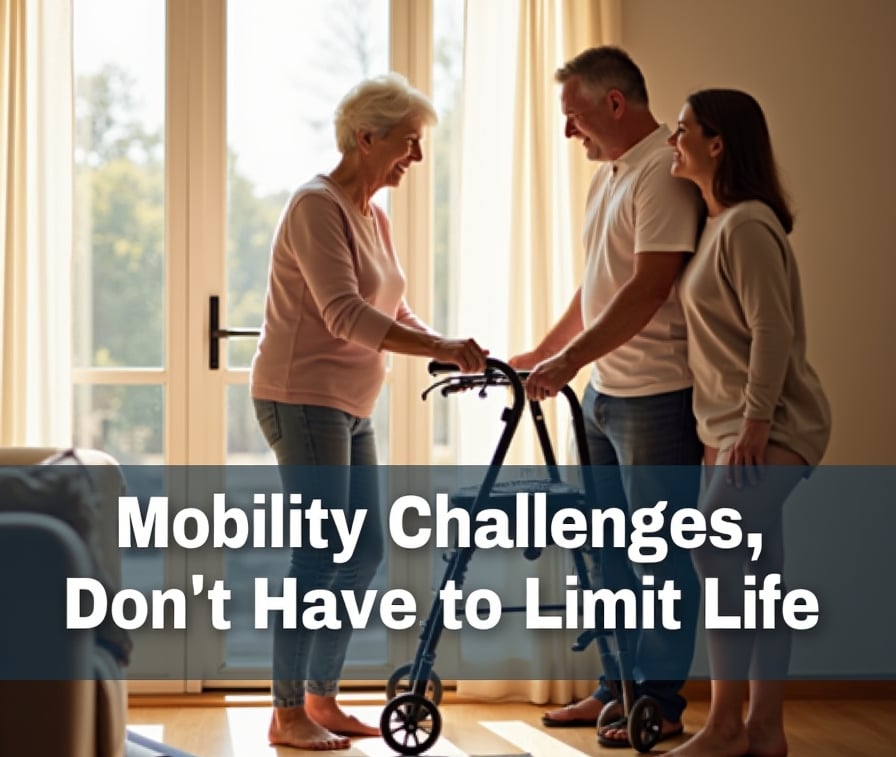Title: Overcoming Mobility Issues in Seniors: Practical Solutions for a Better Quality of Life
Discover practical solutions for senior mobility issues. Learn about walking aids, home modifications, and therapy options to keep older adults active, safe, and independent.
Javed Niamat
10/1/20253 min read


Title: Overcoming Mobility Issues in Seniors: Practical Solutions for a Better Quality of Life
Introduction:
Mobility challenges are one of the most common issues faced by seniors. As people age, their physical strength, balance, and flexibility often decline due to conditions like arthritis, osteoporosis, or neurological diseases. Reduced mobility not only limits independence but also affects emotional well-being, leading to feelings of isolation and helplessness. Thankfully, advancements in healthcare, home modifications, and support services provide effective ways to address these challenges. In this article, we’ll explore mobility issues in depth, their causes, and practical solutions to improve the quality of life for seniors.
Understanding Mobility Issues in Seniors
Mobility issues refer to difficulties in moving around safely and independently. They can range from minor stiffness to severe disability. According to the Centers for Disease Control and Prevention (CDC), nearly 40% of adults aged 65 and older report difficulty walking or climbing stairs (CDC Report).
Common causes include:
Arthritis – Chronic joint inflammation that causes stiffness and pain.
Osteoporosis – Weakening of bones leading to fractures.
Parkinson’s disease – A neurological disorder that affects movement and coordination.
Muscle Weakness and Sarcopenia – Age-related muscle loss.
Stroke or Neurological Conditions – Can impair balance and movement.
Injuries and Falls – Previous accidents may reduce mobility confidence.
The Impact of Mobility Problems
Mobility limitations affect more than just physical health. They influence mental, social, and emotional aspects of life as well:
Loss of Independence – Seniors may feel dependent on others for basic activities like bathing or grocery shopping.
Isolation – Difficulty moving can prevent participation in social gatherings, leading to loneliness.
Increased Risk of Falls – Limited mobility often raises the chances of falling, which can be life-threatening for older adults.
Mental Health Issues – Depression and anxiety are common among seniors struggling with physical limitations.
Practical Solutions for Mobility Issues
1. Walking Aids and Assistive Devices
Canes: Provide balance support for mild mobility problems.
Walkers: Offer greater stability and are useful for those with balance challenges.
Rollators: Equipped with wheels and seats, rollators provide support and resting options.
Wheelchairs and Mobility Scooters: For severe mobility limitations, these devices offer independence in movement.
Learn more about choosing the right mobility aid from the Mayo Clinic (Mayo Clinic Mobility Aids Guide).
2. Home Modifications
Creating a safe home environment is critical for seniors with mobility issues. Some effective modifications include:
Installing grab bars in bathrooms and near stairs.
Adding ramps for wheelchair or walker accessibility.
Using non-slip flooring to reduce the risk of falls.
Ensuring good lighting in hallways and staircases.
Widening doorways to accommodate wheelchairs.
The AARP HomeFit Guide provides valuable resources for aging-friendly home designs (AARP HomeFit).
3. Physical Therapy and Exercise
Engaging in regular physical activity helps maintain muscle strength, balance, and flexibility. Physical therapy plays a vital role in rehabilitation after injuries or surgeries.
Balance Exercises: Tai chi, yoga, and chair exercises improve stability.
Strength Training: Resistance bands and light weights strengthen muscles.
Flexibility Routines: Stretching exercises keep joints flexible.
Studies show that seniors who exercise at least 150 minutes per week have improved mobility and reduced fall risks (NIH – Physical Activity and Older Adults).
4. Technology and Smart Devices
Modern technology is transforming elderly care:
Wearable Devices: Track steps, heart rate, and detect falls.
Voice-Controlled Assistants: Help control lights, appliances, and emergency calling.
Telehealth Services: Provide medical consultations without leaving home.
5. Community and Social Support
Isolation worsens mobility issues. Encouraging seniors to engage with community centers, exercise groups, or senior clubs promotes both physical activity and mental well-being.
Volunteer drivers or ride-share programs can assist with transportation.
Senior community centers often offer fitness classes tailored for older adults.
6. Medical Interventions
Sometimes medical treatment is necessary to address underlying causes of mobility problems:
Joint Replacement Surgeries (hip or knee).
Medications for arthritis and bone health.
Orthopedic Supports like braces.
Regular Checkups to monitor chronic conditions.
Preventing Falls: A Critical Priority
Falls are a major concern for seniors with mobility challenges. According to the World Health Organization (WHO), falls are the second leading cause of accidental injuries and deaths worldwide (WHO Falls Fact Sheet).
Fall prevention strategies include:
Wearing supportive footwear.
Keeping pathways clear of clutter.
Using nightlights for safe movement in the dark.
Practicing daily balance exercises.
Emotional and Psychological Support
Seniors with mobility issues often experience feelings of frustration and loss of independence. Families and caregivers can help by:
Encouraging open conversations about their struggles.
Offering emotional support and patience.
Connecting them with support groups.
Involving them in decision-making for their care.
Conclusion
Mobility issues in seniors are not just physical problems; they affect independence, mental health, and overall quality of life. However, with proper walking aids, home modifications, physical therapy, medical interventions, and emotional support, seniors can lead fulfilling lives. By fostering independence and providing compassionate care, we can ensure that aging does not mean losing mobility or dignity.
For caregivers and families, being proactive in addressing mobility challenges is an investment in the safety and happiness of their loved ones. Small changes—like installing grab bars, encouraging exercise, or choosing the right mobility device—can make a huge difference.
Key Resources: